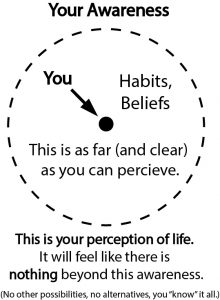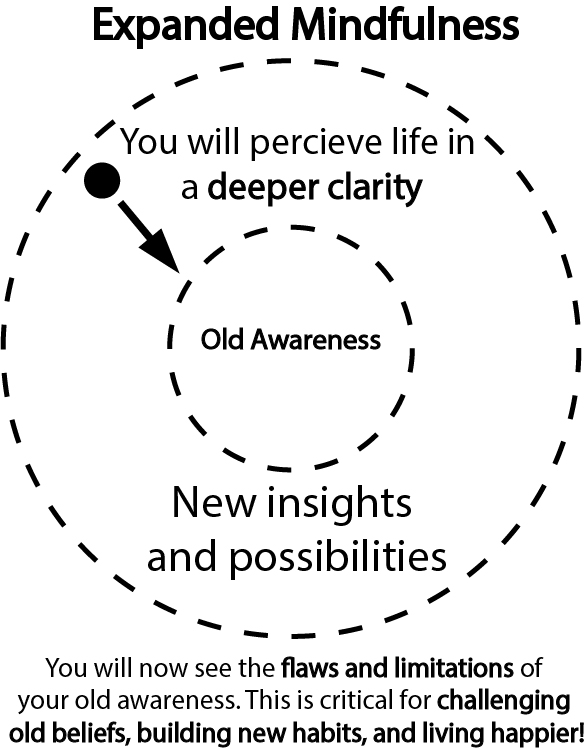What is mindfulness? What are it’s benefits? This article embarks into the world of meditation and how it helps us master our lives and find the beauty in everything.

What is mindfulness?
First off, mindfulness is the ability to be fully aware of the present moment (what you are experiencing right now.) Although we can practice mindfulness throughout the day (while eating, showering, driving, and walking, and so on), mindfulness meditation focuses entirely on mindfulness alone. It is about acknowledging what we see, hear and feel without judgement, allowing it to pass and go without resistance.
Mindfulness helps with our creativity because we become master observers
Like a scientist, we need clean instruments to observe the world around us. Mindfulness labeling “cleans” our vision, sharpens our senses, and makes us sensitive to the environment. Sharper senses mean we get accurate “data.” Because of this, we become more creative through mindfulness meditation and we discover insights about our lives!
In order to transform ourselves, we first need to learn about our human nature, our habits, and our weaknesses. Therefore, how can we master our lives if we cannot find the “buttons and levers” within us? With even a month or less of practice, mindfulness helps us to connect the dots and to find patterns in our own behaviors that we generally overlook.
Mindfulness meditation “wakes us up” from our greatest fears
Mindfulness meditation helps us become aware of what is going on around us. Why is this the case? Let us compare it to a lucid dreaming metaphor: A lucid dream occurs when someone realizes they are dreaming because they mindfully recognize something “odd” or “unreal” about the experience. Whatever we are afraid of, whatever character we believed to be and the story that came with it – it all melts away when we realize it is a dream.
Imagine a pack of wild animals are chasing you and there is nowhere to hide. You are having a school nightmare such as failing a test or missing class. The person you love the most is in grave danger. Now, if you have had a nightmare similar to these, do you remember how relieving it was to realize it was just a dream? Do you see how radical of a shift that is to us when we can distinguish which problems are real and fake?
Similar to lucid dreaming, mindfulness meditation helps us have that same radical shift in real life. We get caught up in the “dream” every day. We get lost in our thoughts, our emotions, worries, doubts, and fears.
Through mindfulness, it is possible to discover that there is nothing to fear and no reason to run, because all of the problems in the “dream” that we call life are not as real as we think.
Because we create stories about our lives, fantasies, conflicts, and tragedies come with it. Mark Twain once said that, “There has been much tragedy in my life; at least half of it actually happened.” Whether it is disappointment, failure, or loss, we fear many stories in our minds that end up never happening. Mindfulness meditation wakes us up from that “nightmare!” With greater mindfulness and mental clarity, the easier it is to melt away the fake stories and to enjoy what is real.
What is the point of mindfulness?

For someone who has never done mindfulness meditation before, it will seem like a pointless exercise.
We assume that we already know everything that is possible for us to see, hear, and feel.
However, consider this possibility: When our field of vision is limited, the harder it is to realize that we aren’t mindful! Have you noticed that the most ignorant of people don’t realize what they are ignorant of? They are the loudest, the most sure of themselves, and the most close minded.
As a side note, I’m not trying to judge or pick on ignorant people. The only reason I brought it up is for us to recognize in ourselves that we fall for the same traps they do! There are many things in our own lives we are ignorant of and it hurts us every single day.
The less mindful we are, the harder it is to master our own lives. The worst scenario is when we don’t realize that we are blind and we suffer for it! “I don’t understand why I can’t eat healthy every day.” , “It doesn’t make any sense why that guy is acting so stupid.” , “I know I am not supposed to stay up too late because I have work tomorrow, so I don’t understand why I keep going to sleep at 3:00 AM watching videos!” When
we struggle throughout the day, strain, stress, and bash out in anger, we do this because we are frustrated by how we cannot see the problem and the solution clearly.
It is rare to be in the present moment (what we are experiencing right now). Mindfulness labeling exercises our “eyes” so to speak. Once we strengthen the mindfulness muscle, it allows us to observe our sensory experiences from an objective point of view. Then, we can finally learn from our mistakes!
These previously mentioned points are reasons (but not exhaustive) of why mindfulness is crucial for us to live a fulfilling and joyful life.

Meditation is “now sight”
Hindsight occurs when we regret our past life experiences. This is because we are more mindful than the moment when we made our mistake. However, mindfulness meditation is like having hindsight right now, it is now sight! We rise above our reactions, emotions, thoughts, and automatic behaviors before we make mistakes.
How do we know when we are not mindful? How does it affect us?
A major sign that we are not mindful happens when we try to stimulate and busy ourselves with junk food, entertainment, social media, overworking, and day dreaming. Some may ask, “Why wouldn’t we do these things and why are they not mindful?
Think about it this way: Why do we immediately turn to these habits when there is nothing to do? It is because we are disconnected from the subtle joys of life. Because our senses are numb, we turn to stimulation because we want to feel something. The most obvious examples are addictions to drugs and alcohol. The more we stimulate ourselves, the further we develop a tolerance to that stimulation. Because of its diminishing returns, we need more to experience the same amount of stimulation as before.
Not only is this prevalent in “obvious addictions” but in subtle ones as well. We call it boredom! We jump from one activity to the next, one video to another without any gaps to appreciate our natural state of “just existing.” Don’t believe me? Next time you are on your phone, try to be mindful of how you jump from one activity to another to avoid the present moment, being still, or just thinking about life.
The human mind and body is an amazing machine that adapts and evolves itself to new situations. Just as we can become numb and develop tolerance to our surroundings, we can also become sensitive to it. Through mindfulness, we become sensitive and hyper aware to the subtle aspects of life; the feeling of our clothes, feeling a light breeze, hearing conversations in the distance, and the delicious taste of a sandwich, and so on.

Even through short periods of mindfulness, we can realize that our lives are more defined than any high-definition TV.
Without mindfulness, we are very judgmental
We want to minimize pain and maximize pleasure. From what we see, hear, feel, smell, and taste, we consider different experiences to be ‘objectively good and bad.’ Why does this happen? It is because our perception is biased in order to serve our survival needs. Here is an example: If you do not drink anything for two days in the desert, a bottle of water would the sweetest and most succulent thing you would ever drink. On the other hand, if you are over-hydrated and bloating, even the thought of water is repulsive. The water does not objectively change, you do.
In other words, we put “good and bad” labels on everything based on how those experiences serve us. Anger is bad, sugar is good, warm showers feel nice, cold showers are the worst, and so on. This is not a bad thing! In fact, it is entirely natural and useful because it helps us nourish our body and protect ourselves from danger!
Although these labels and judgements help us survive, it can also sabotage our joy if we get lost in our reactions. In addition, avoidance of pain or discomfort is a double edged sword. It can harm our wellbeing when the greatest rewards come from discomfort or pain. As an example, an avoidance of pain could mean avoiding exercise. A seeking of pleasure and avoidance of boredom leads to distractions and a lack of self-reflection. An avoidance of discomfort will lead to no growth, no stretches, and no bravery to meet others or to take risks. How we label the things around us effects how we will live, how we make decisions, and whether we experience joy or suffering in the moment.
The best way to determine whether we are mindful or judgmental in this situation is to recognize if we have any tension in our body. Tension is our defense mechanism to resist or avoid experiences. We clench our jaw when we are annoyed, bite our nails when we are anxious, tighten our body when we are cold, and cross our legs or hide our hands when we feel vulnerable around others. If we treat life as something we have to “manage or deal with,” then we waste our time and energy waging wars on our self and our surroundings.
Without mindfulness, we immediately draw conclusions that one experience is good while another is bad. When we experience the latter, we tighten our muscles, suck in our belly, and think, “I hope this goes away soon. I’m cold, tired, hungry, and bored. Anything I would do to end this! Can I go home now?”
Mindfulness labeling watches life happening with no judgement! At first what appears to be forced tolerance becomes a natural and authentic appreciation for all aspects of life. It is giving everything a chance to be what it is supposed to be without us manipulating or resisting it. When we observe our “see, hear, and feel” sensations clearly, we learn that there is nothing inherently wrong with anything. In the contrary, life becomes beautiful.
Here are a few examples of how mindfulness can give us insights and make life more joyful:
- You could realize that cold showers aren’t as bad as you once thought. In fact, you could compare the feeling (the physical sensation) of the cold to the feeling of eating sugar. The sensation of the cold and eating a York peppermint patty is nearly identical. The cold is like candy!
- One can find that stress and adrenaline are synonymous. How we interpret and react to the stress determines whether it harms or empowers us.
- Fear is also similar to adrenaline. This connection is obvious for anyone that enjoys watching horror movies or thrill seeking.
- Another through awareness realizes that their problems and fears (regarding relationships, career, grades, school, and social life) are conceptual thoughts, not substantial and have nothing to do with the present moment.
- A very advanced application of mindfulness is when pain no longer causes suffering. As an example, one can remove their wisdom teeth and no longer need pain medication because their state of equanimity eliminates any form of suffering associated with pain and can even turn into joy.
Now that we have a general idea of what mindfulness is, here is some homework to put all of this into practice:
In the future, United Insights will post more articles on how to meditate and practice mindfulness. For the time being, the first step to becoming mindful is recognizing when we are not mindful! In order to do that, here are a few possible examples:
- When you are with a group of friends and everyone is silent, notice how you and your friends immediately jump to their phones.
- While you eat unhealthy snacks like a bag of chips, you immediately turn on some form of entertainment or you get lost in a daydream. Vice versa, when you are watching entertainment, you crave junk food.
- Notice how difficult it is to sit and do nothing. You daydream about a movie you watched last week, working on a to-do list, begin stressing about the upcoming exams, and so on.
- Also acknowledge when you turn to distractions in order to avoid fears or upcoming problems such as a deadline or a truth about yourself you do not want to admit.
- Recognize when you “replay” and argument or conflict that happened in the past. Notice how you bring it to the present and how it hurts you.
- Wear a bracelet that reminds you to find any tension in your body, whether it is sucking in the belly, clenching your fists, tightening your legs and back, and so on.. Like a laser beam, focus on that tension until it melts away.
- Observe sensations without judgement. Why does the feeling of cold not feel like warmth, sourness, or like an electric shock? What makes these sensations different? (Don’t try to rationalize it with scientific theories about electrons, bouncing molecules or cells. Notice all of these explanations are just thoughts! Instead investigate it from your direct experience, what is there right in front of you.)
Lastly, here is an important point; Do not beat yourself up when you realize you are not mindful!
Do not say things to yourself such as:
- “Oh crap, I got lost in my thoughts again. I shouldn’t do that!”
- “How dare I watch Netflix to avoid my homework deadlines!
- “Bad me for judging other people!
Why should you not do that? Because you are just adding more thoughts and judgements on top of your thoughts and judgements!
Do not judge your judgements, just acknowledge it and allow them to pass.
Conclusion:
That is all for now. Now that we have explored the theory of what mindfulness is and how it can improve our lives, expect cool techniques and exercises to come soon! Have any questions or objections about mindfulness? Did I miss anything important or confusing? Have any experiences similar to the examples shared above?
Share your insights with us! – Justin

One thought on “An Introduction to Mindfulness: Become a Master Observer Through Meditation”